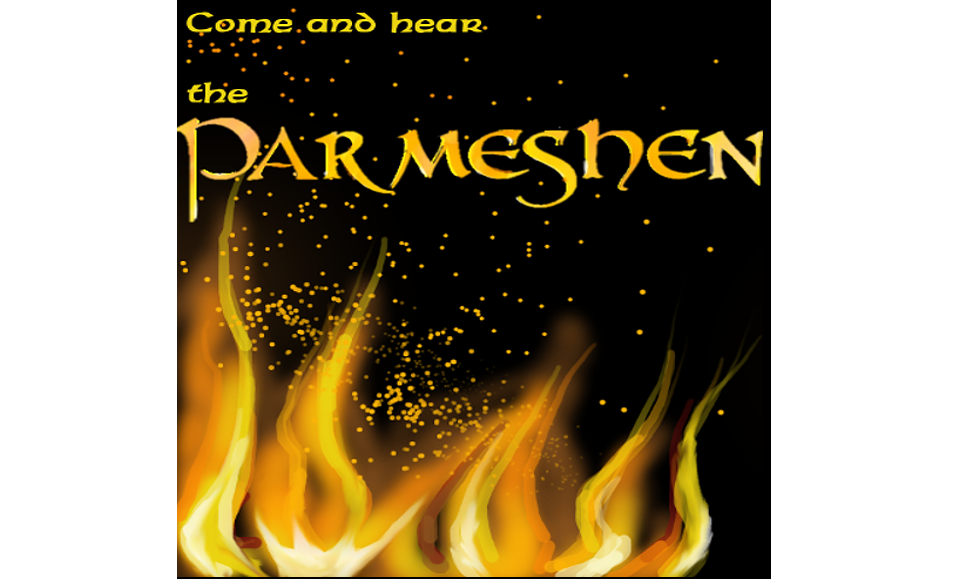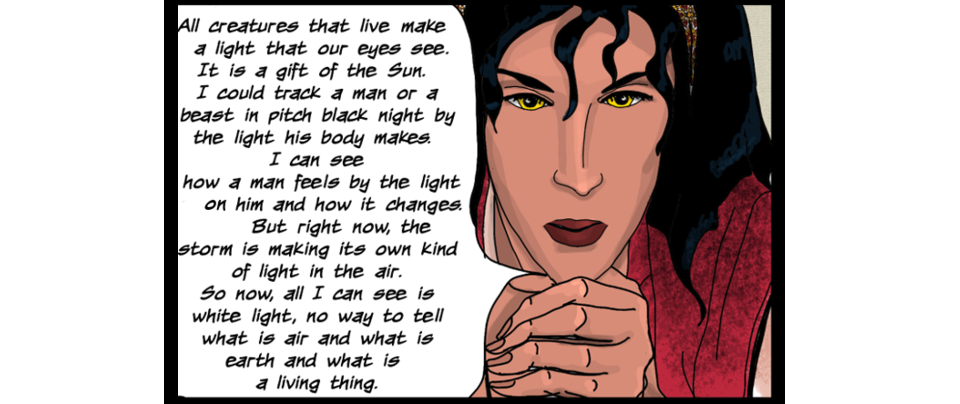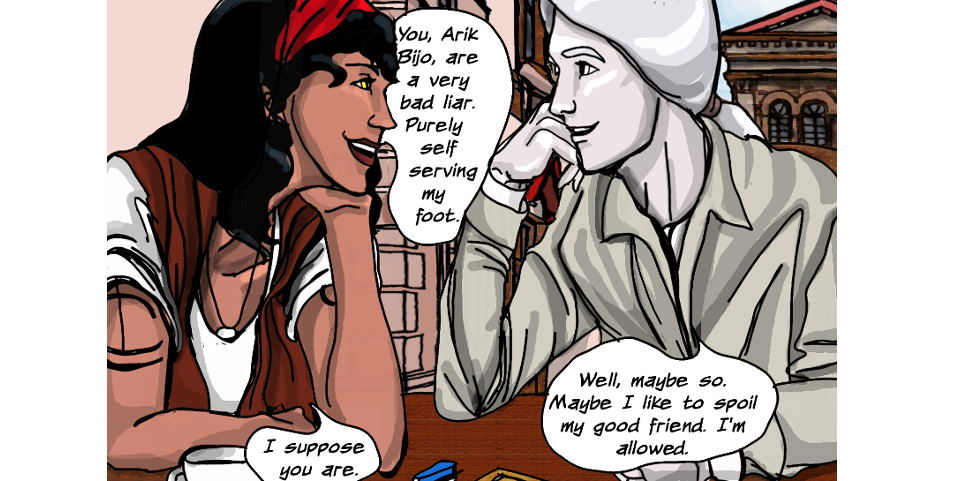
The Review Daemon: Parmeshen
Today’s critical review is on the webcomic Parmeshen, with art by Olivia Wylie (who we’ve previously interviewed) and story by Tori Kinnaman and Emily Singer.
Synopsis:
Boy, have I got something great for those of you who like character-driven stories. This is Parmeshen, a tale of friendship, respect, and overcoming social barriers and prejudices. It’s also a story of bonds—bonds between friends and loved ones, between colleagues, and family. Amidst it all, there’s a constant theme of personal growth, discovery, and learning to lean on another person’s strengths to overcome your own weaknesses while using the strengths you have to help others. It’s also a story about stories, and the things people learn from tales of the past. It’s a lot of things at once, and all of these things are fascinating in their own way.
Plot and Writing:
The comic begins with Baxt traveling through a large capitol city. During her visit, she runs into some thugs and an agent named Arik intervenes. To her chagrin, she must repay her debt as per the customs of her people. Arik accepts these terms and asks her to teach him her language, which she begrudgingly agrees to do. As she teaches him, it becomes apparent that they both have something in common—they’re both a member of a misunderstood and persecuted group, and Arik expresses a strong desire to reach out to Baxt because of this commonality.
At first, Baxt is averse to getting close to an outsider, but as they two get to know each other, they eventually become friends. They teach each other and help the other with their problems. When an apparent serial killer begins targeting Baxt’s people, Arik decides to take action and use his authority and resources as an agent to put a stop the murders, while Baxt uses her social connections to gather information to catch the killer. The two must cast aside past hurts, personal reservations, and even violate social taboos to call on the help of friends, family, and work associates throughout the city in order to put a stop to the violence.
It’s a pretty suspenseful story once the major conflict kicks in. The trouble is it takes a long time to happen. Of course, in the meantime, we get to see the characters fleshed out and develop, so if you like character-driven stories, you’ll like this just fine. But if you’re in a rush to get to the main conflict, you’ll have to wait a while.
As a side-note, I would bet actual, factual money that this story has some kind of world-building bible behind it. The author puts in a lot of small details that suggest tons of work went into this setting. The language of Baxt’s people, for example, seems to have a fully thought-out grammar system and general vocabulary. I get the sense that some other details are a little under-used, though. For example, we know tons of non-human sapient beings exist in this setting. Baxt even lists a bunch of them early on. And yet, aside from some cameos, we don’t learn much about most of them. It doesn’t make the plot any weaker, but I do wonder about some of these details. Perhaps they will come out later. This is, after all, a story that likes to take its time.
So my verdict here? For what it wants to be, I think it’s doing it perfectly. Whether or not a reader likes it would be more a matter of the reader’s taste than the author’s skill. Looking for a slow-building fantasy that’s heavy on character development? This one’s for you.
5/5
Characters:
Buckle up, because this section is going to be real long. I have nothing but good things to say about these characters, but there is just so much to say! And the major themes of this comic tie in very closely with the way the characters develop.
Behold, the rare example of a comic that handles the topic of social prejudice with just the right balance. Believe me, I’ve read a lot of well-meaning works that are just inept with this sort of thing. It’s not just a sensitive topic—it’s a complicated one. Not everyone has what it takes to tackle it.
At the risk of saying something potentially controversial, I’m going to propose a personal hypothesis; stories which deal with social prejudice are ultimately dealing with human nature, albeit an ugly aspect of it. For stories like this to work, you have to be prepare to bare the souls of your characters, both the best and worst parts of who they are, and that’s really the greatest strength of this comic.
Every major character is likable, yet realistically imperfect. Whether the imperfection lies in a personal failing, or simply a certain weakness or vulnerability they cannot overcome alone, everyone feels genuine. Granted, there’s actually a pretty small pool of characters. The world feels huge—there are so many minor characters—but the major players are relatively few. That’s not a bad thing, though. The author is very good at establishing the general culture and attitude of a crowd. The core cast may be fairly small, but they don’t live in a vacuum.
The most prominent characters are Baxt and Arik, who I’ve already touched on. A huge chunk of the story revolves around the way these characters interact and how their relationship evolves. It starts out as a very strained relationship. Baxt isn’t just reluctant to associate with him because he’s an outsider, she’s afraid of accidentally exposing vital secrets about her people. For her, this is one of their most sacred taboos, and just being around Arik risks violating it. Her fears are slightly alleviated when Arik turns out to be in earnest about simply wanting to help and understand her people, but it takes her a long time to finally trust him and she keeps him at arm’s length for quite a long while.
While Baxt has the negative experiences to justify her concerns, the story doesn’t imply she’s right to cast suspicion on Arik in particular. As the story goes on, she learns that he really did deserve her trust from the start. This is what I like about the way the story handles prejudice—Baxt herself has prejudices too, and while she’s shown in a sympathetic light, she’s also allowed to be proven wrong. People don’t form their prejudices out of nowhere, and the cause can even be perfectly understandable, but part of Baxt’s personal journey is learning to trust and respect the outsiders who make the effort to meet her halfway. While she can come across as aloof and even haughty, she’s such a vibrant, intelligent, and courageous person that it’s hard not to like her. She’s not flawless, but she’s a wonderfully interesting and well-written character.
Of course, while Arik is not as closed-off as Baxt initially is, he isn’t perfect himself. For one thing, he’s a workaholic with deep insecurities. His is a different kind of prejudice—one which he directs inwardly, struggling to keep at bay the fear people project on his kind. Additionally, he is law-abiding and idealistic, but naïve. Baxt sometimes has to make him face messy issues from her perspective, the perspective of somebody whom the law has failed. This proves difficult for Arik, who believes in the sanctity of the law whole-heartedly. But, like Baxt, despite his weaknesses, he remains likable. He is kind and honorable above all else and he cares deeply about doing the right thing.
The relationship that develops between them allows them both to grow as people, and it progresses at a steady, yet believable pace. They have such an organic and touching dynamic. I won’t dare spoil how exactly things progress. I will say it becomes a central and critical part of the story and that it is handled excellently. I highly recommend reading this comic just to see these two get to know each other.
As for the remaining minor characters, I really like the people Arik works with. His boss, Commander Yma, is a witty, tough woman who clearly cares for the people she works with, and the other agents in general seem like a tight-knight group of individuals who bring out the best in each other.
For example, when Arik gets a trainee, at first, he’s pushed aside and seems like he’ll be a possible obstruction, but no. He turns out to be a valued member of the team with a lot to contribute, even if he also has personal flaws to overcome. Baxt’s people are also wonderful to watch. They’re quite a lot like Baxt herself—vibrant, intelligent, brave people with a fascinating history. You can feel their closeness with each other. Camaraderie in general seems to be a major theme in this story. The more people unite with each other, the stronger and more enlightened they become—and that’s a great message.
5/5
Dialogue:
I like how the characters speak for the most part. Baxt in particular is quite poetic, especially when she’s telling a story. Sometimes the dialogue comes out sounding a bit on-the-nose, though. The characters do tend to slip into info-dumping pretty frequently. Sometimes the dialogue rambles a bit and while it’s mostly interesting, it could be broken up in a way that’s not quite so dense. I don’t have too much else to say about this. It’s good, but sometimes the conversations seem more like debates than conversations.
3.5/5
Lettering:
The lettering is honestly kind of sloppy and it’s my least favorite thing about this comic. I really don’t like the placement of the world bubbles at all. Ideally, word bubbles can be artistic and creative in a way that matches the art style. Ordinarily, they’re just simple and unobtrusive. These word bubbles are incredibly intrusive. Look at how much this one dominates the panel.
The lettering constantly gets in the way and sometimes the order of the dialogue is a bit unclear because it’s put on the page is such a cluttered manner. The only thing I like is the languages get different fonts, so I can tell what language is being spoken. That’s pretty common fare in comics where characters speak more than one language, but I still like seeing it.
2/5
Art:
The colors are what stand out to me most of all. This comic loves its warm tones. Reds, browns, and shades of gold are prominently displayed, giving a vivid and lively feeling to the pages. Of course, it does use the full spectrum of colors, but it’s those warm tones that stand out. Often, you’ll see some contrast between that and the monochromatic tones associated with Arik. It’s a nice juxtaposition, but I’m almost always drawn to the brighter tones. That’s just how the eye tends to fall on things, so in panels like the image below, the main focal point tends to be Baxt by default even though the image composition gives both characters equal room.
Texture seems to be a big theme in the art direction. Metallic textures are especially common, thanks to Arik’s true form. Elaborate repeating patterns on fabric also come up a lot. But while I see the effort, the effect isn’t very tactile at all. The textures are there, but it looks more like a lot of repeating patterns filling in a silhouette, rather than having their own depth. For example, the tea on this page—it has some lovely color choices, the highlights and shadow don’t follow the motion of the line-art. The result is a texture that would otherwise have the illusion of depth looking strangely flat and pasted-on.
I like the idea, but it could use more refinement. I would also recommend the art experiment with some different blending techniques. Maybe also consider using a softer style of lineart, perhaps one that has a more painterly quality. I daresay something like a textured pen or charcoal could give a certain softness to the lines that gives those textures more breathing room.
3/5
Paneling and Visual Storytelling:
I find the paneling to be pretty decent. Instead of white gutters, as most comics use, it has solid black gutters that blend into the black background of the website. I actually like the effect. It’s very sleek and cohesive. As for the visual storytelling, sometimes the action looks stiff—the anatomy could be more fluid—but otherwise everything works fine. And the comic likes to try on different kinds of imagery to tell the story. Sometimes it shifts into different art styles. Sometimes it’s all silhouette. Sometimes the pages are letters Baxt and Arik send each other. I like the variety overall. The biggest issue I have is the action scenes have close-ups too often and that makes it hard to follow sometimes.
4/5
Website:
I love this website’s design. It’s so simple and uncluttered, yet it works so well. Usually black backgrounds are kind of empty-looking, but combined with the warm colors of the comic and elaborate navigation buttons, it’s a perfect balance, neither too stark or too busy. The arrows at the bottom of the pages are quite creative, as well. Even though they don’t have the typical “first”, “next”, and so on as labels, the placement makes it obvious what they’re meant for. The only real criticism I have is that lettering that appears when you hover over the icons on the top of the page is hard to read. I think if the lettering stayed dark, but the icon behind it faded to a more pastel version, it would be a lot easier to read at a glance. But other than that, I can’t find any fault with the site.
5/5
Summary:
I really enjoyed reading this comic. I honestly was disappointed when I reached the end. It’s well-written and has some wonderful characters. Even though it has some pretty big visual weak points, I still liked the artistic direction overall. It’s just a little unrefined in my opinion. This comic is still definitely worth checking out, but it’s also a commitment. You have to be able to appreciate slower-paced stories that focus on developing characters over exciting action and gripping plot twists. If you want the latter, you might find this one a bit lethargic. But if you’re like me and you want to get lost in the characters, this is a great story to pick up. It has its share of excitement, but it really is those more subtle moments that shine most brightly and I really appreciate that about this comic.




